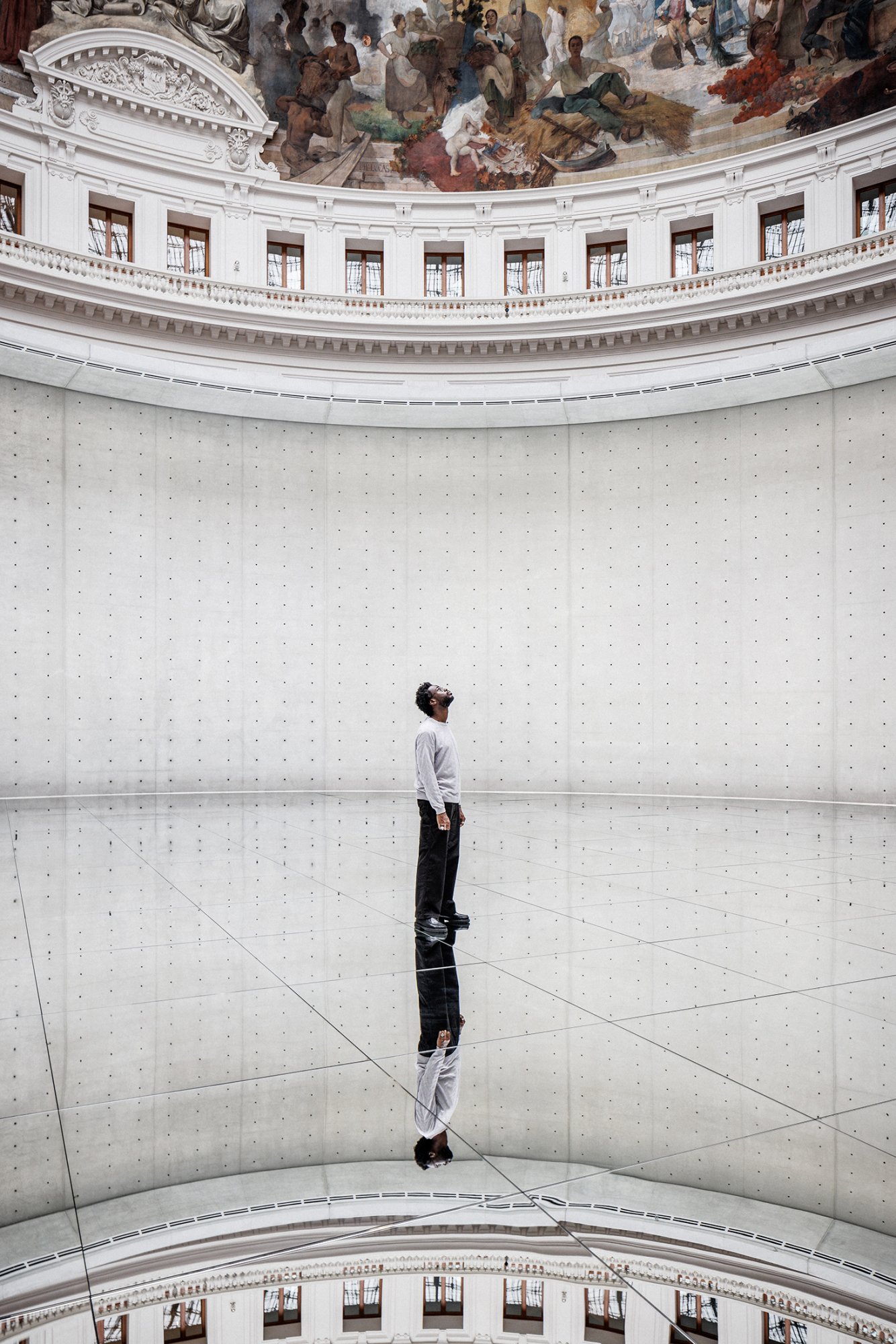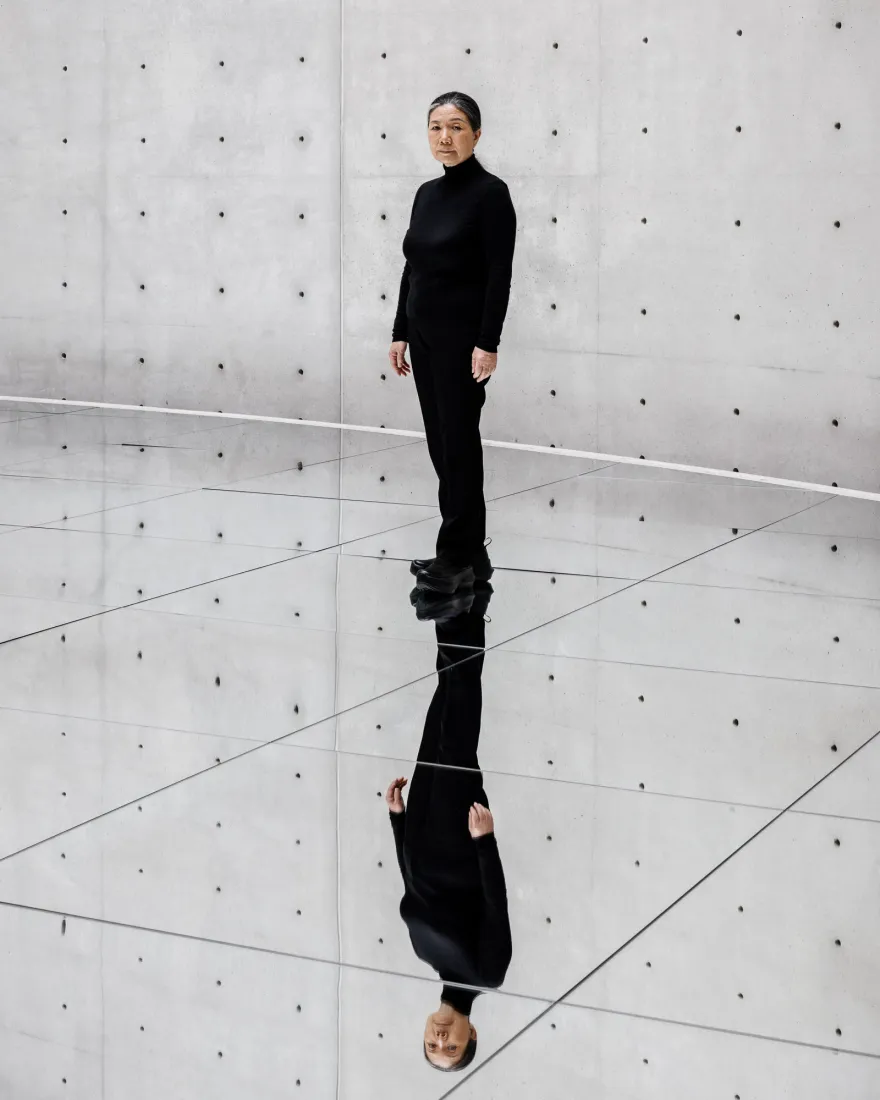Carte blanche to Kimsooja

As part of the "Le monde comme il va" exhibition, South Korean artist Kimsooja presented a carte blanche entitled "To Breathe - Constellation" from March 13 to September 23 2024
Her installation in the Rotunda of the Bourse de Commerce is both monumental and ethereal: an immense mirror on the floor that, as one approaches, inverts the architecture and the order of the world with it, the sky opening up in the middle of the building, beneath our feet. Kimsooja is also taking over the 24 display cases in the Passage and the lower level of the museum with works and video installations that address her favourite themes: identity, borders, memory, exile, movement, and weaving.
“I would like to create works that are like water and air, which we cannot possess but which can be shared with everyone”, Kimsooja says. Since the late 70s, her work has asserted itself on the international art scene as an essential, universal experience. After studying painting in Seoul, she distanced herself from all art teachings and practice, embracing everyday gestures such as sewing to explore the issues of identity, involvement, individual and collective memory, and the individual’s place in the world. In the performance in 1997 that made her famous, she spent eleven days travelling across Korea perched atop a lorry loaded with bottaris, the traditional, shimmering Korean fabric bundles used to mark major events in people’s lives, from birth to marriage to death.
As a nomadic artist, a “cosmopolitan anarchist” as she calls herself, Kimsooja metaphorically uses her own body like an anonymous, almost invisible presence whose immobility and verticality become a kind of needle that threads through the fabric of the world.
The mirror that she has used to cover the floor of the Rotunda of the Bourse de Commerce plays a similar role to that of the needle or of her own body.
“The mirror replaces the body, observing and reflecting the other”
“By using it, our gaze acts like a sewing thread that moves to and fro, entering into the depths of our self and of the other, reconnecting us to their reality and inner world. A mirror is a fabric woven by own gaze in an ebbing and flowing motion”. Kimsooja transfigures the architecture into a dizzying, levitating space, an inversion of the world in which the sky in the glass dome becomes a deep abyss, thereby altering our perception of the space and our sense of the gravitation of bodies. She hollows out the architecture and leaves an empty space to generate new sensations and perhaps also the sense that our body acts like the one in Needle Woman: an axis that binds the sky to the earth.
In resonance with the thinking of Tadao Ando and his quest for an architecture of the empty and the infinite, Kimsooja has covered the floor of the Rotunda with a mirror. She thereby transforms an artwork into something more than just an object, an installation, or an image; it instead becomes an essential experience. Between appearance and disappearance, contemplation and astonishment, light-headedness and amazement, the thus-transfigured empty space is no longer, in the words of François Cheng, “an inert presence; it is filled with breaths that connect the world we can see to the one we cannot”. The mirror that Kimsooja offers us also moulds the space into a gathering, the possibility of a totality that invites us all to create a world together.
An artist of movement, crossings, and a profound nomadism, Kimsooja has filled the display cases in the Bourse de Commerce with a constellation of works covering almost forty years of her artistic practice, as if she were finally setting down her bags after a long journey. She gives form and life to objects that may seem inert, and which express her interest in intangible presences that blend delicately with the invisible and the ephemeral. She sets works in motion that are often spherical, from grains of sand to flax seeds, porcelain and clay marbles, fabric bottaris, and earth-coloured “moon jars”. These compositions form miniature worlds, microcosms within the closed space of the display cases. It as if they have been put back into circulation, like an intangible choreography, driven by the gestures of the artist who brought them into being and spurred on by the slow, inexorable course of the stars that move across the immense glass oculus.
In his Spheres trilogy (1998-2004), Peter Sloterdijk sketches a philosophical history of humanity through the prism of this fundamental form of the sphere, which he believes enables humans to invent their own material, symbolic, and cosmological environment, which in turn allows them to inhabit the world. Each clay sphere, fashioned in the hollow of Kimsooja’s hand, participates in the formation of a universal cosmogony and awakens the power of the archetypes and myths contained in the clay, the raw material of the human body. Each bottari is like a skin that envelops the body from birth to death, like a shroud. As a metaphor and extension of the human body in its constant mobility throughout the cycle of life, the bottari interweaves Asian and Western cultures, the everyday and the artistic, the individual and the universal, the past and present, life on earth and cosmic time.
The enigmatic A Needle Woman (1999-2000) is a performance video by Kimsooja in the Pinault Collection. Kimsooja stages herself at the four corners of the earth (Shanghai, Delhi, Tokyo, and New York), standing alone, her back to the camera, immobile, like an axis interacting with – and resisting – the tumult of urban life. In this work exhibited on the lower level of the Bourse de Commerce, Kimsooja makes metaphorical use of her own body, which becomes an anonymous, almost invisible presence. Through its immobility and verticality, it threads the fabric of the world like a needle, humbly stitching up its tears and snags. With this performance, the artist provides spectators with a symbolic mirror that reflects both the image of a world in constant acceleration and her own identity in relation to that of others.
Curation : Emma Lavigne, General Director of the Collection, General Curator, Pinault Collection
